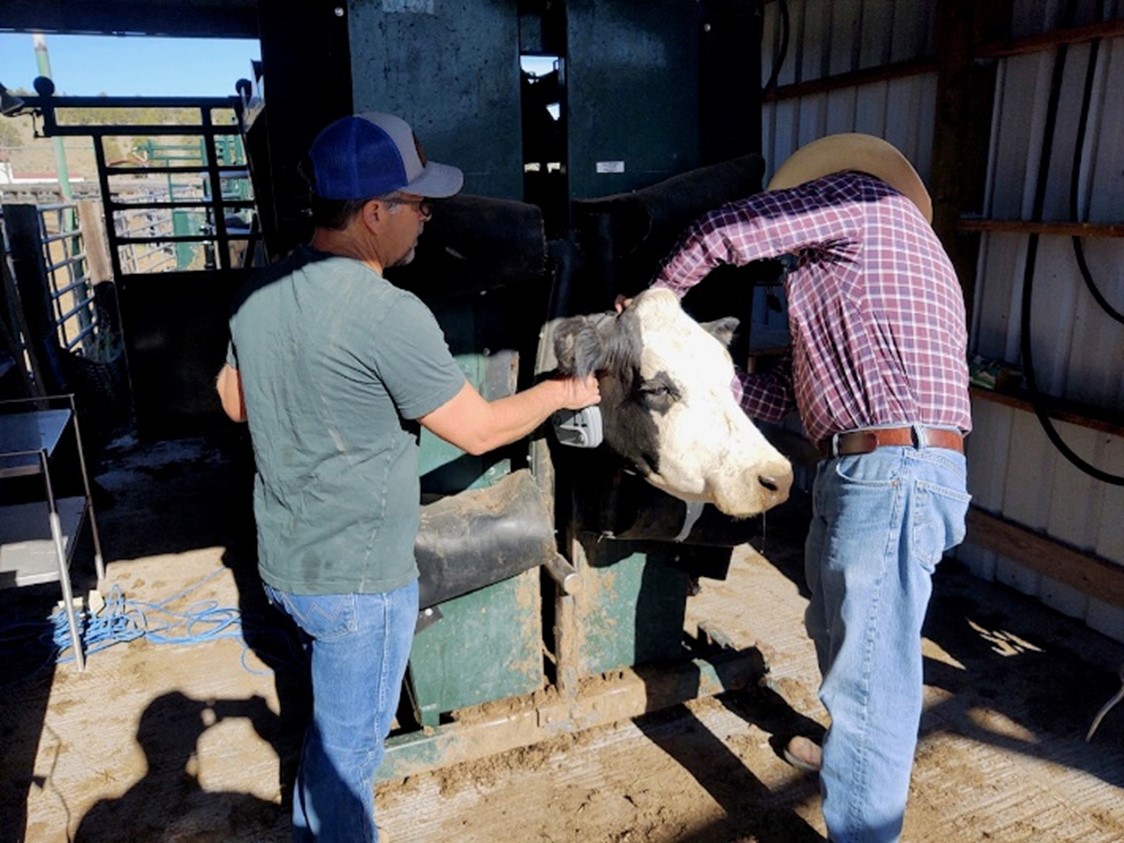What is virtual fencing?

Virtual fencing, a relatively new technology, allows ranchers to control livestock distribution in rangeland landscapes without physical fences. Livestock wear collars that communicate with GPS and reception towers to form a virtual fence set by the rancher or land manager. When the livestock reach the limit of the virtual fence, auditory stimuli (a series of loud beeps) emit from the collar. If livestock continue their direction of travel beyond the boundaries of the virtual fence, they receive a benign shock. Cattle have demonstrated the ability and tendency to rapidly learn the virtual fencing cues, eventually responding to the audio cue alone. Several studies have documented success with sheep and goats as well.
Adapting to a changing climate
Because virtual fencing can help rangeland managers become more adaptive to variable conditions, it could help managers to adapt to the variable impacts of climate change. Virtual fencing can be used to contain animals within a desired area, exclude them from undesired areas, or move them across the landscape without the need for physical fences. For example, as wildfire frequency and size increase in the Great Basin due to climate change and the spread of invasive annual grasses, it is likely that more traditional fences will burn, or areas within traditional fencing units will burn. Virtual fencing could allow ranchers and rangeland managers to reestablish boundaries more quickly for livestock in post-fire environments, or to keep livestock away from recently burned areas.
Virtual fencing also has the potential to improve soil and water quality through making managed grazing more accessible as a practice. Managed grazing is careful management of livestock density and the timing and intensity of grazing. It can stimulate plant regrowth and add manure to the soil. While ranchers with traditional fences can also practice managed grazing, it requires much more planning and labor, and animal movements are limited to pastures defined by permanent fence boundaries. Virtual fencing allows managers to frequently and efficiently move livestock from one pasture to the next and to define new within-pasture boundaries.
- Allows ranchers to change the locations of livestock grazing, both between and within years
- Allows ranchers to move livestock with reduced labor inputs
- Can be used in areas that are difficult to fence
- Eliminates wildlife conflicts with traditional wire fencing
- Can exclude cattle from areas of management concern, including burned sagebrush steppe
- Can prevent overgrazing
- Can limit undesired effects of grazing in riparian areas
- Involves collar installation
- Relies on functional technology
- Has a high upfront cost of implementation
Virtual fencing has proven effective in excluding cattle from riparian areas, areas of management concern, recently burned areas, and areas with regenerating saplings. Virtual fencing has also been found effective in encouraging cattle to graze on undesired/invasive species. In Alaska, virtual fencing is being tested for increasing the efficacy of reindeer reintroduction on the Seward Peninsula. Additional research is needed to evaluate virtual fencing technology in larger rangeland settings, particularly to understand if ease of use changes with scale, since animals interact with larger perimeters less often.
For an example of this adaptation practice in action, view our Adaptation in Action profile of the work the Eastern Oregon Agricultural Research Center completed on virtual fencing as an effective means of excluding cattle from burned areas in sagebrush steppe rangelands.
Virtual Fence User Guide from the University of Arizona and members of the Rangelands Partnership provides practical information and helps virtual fence users navigate systems. This resource compiles information on the basics of virtual fencing, webinars, tools, videos, and more.
-
Grazing Lands in Idaho, Oregon, and Washington
A summary of grazing lands and the effects of climate change in Idaho, Oregon, and Washington.
-
Virtual Fencing Excludes Cattle from Burned Areas in…
This Adaptation in Action profile highlights the exclusion of cattle from a burned area within a sagebrush steppe pasture using virtual fencing technology.
-
Management Actions for Northwest Grazing Lands
A suite of management actions that can assist ranchers, land managers, and producers in mitigating and adapting to climate change.




